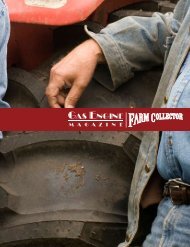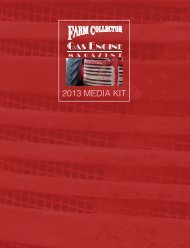Motorcycle Classics Media Kit - Ogden Publications, Inc.
Motorcycle Classics Media Kit - Ogden Publications, Inc.
Motorcycle Classics Media Kit - Ogden Publications, Inc.
- No tags were found...
You also want an ePaper? Increase the reach of your titles
YUMPU automatically turns print PDFs into web optimized ePapers that Google loves.
MOTORCYCLES, MOTORCYCLES AND MORE MOTORCYCLES Every issue of <strong>Motorcycle</strong> <strong>Classics</strong> deliversexciting and evocative articles and photographs of the most brilliant, unusual and popular motorcycles ever made. From legendary bikeswhose timeless designs and innovations have endured for decades to the modern retro classics gracing today’s showrooms, we showcasethe best on two wheels. VINTAGE RACING is a celebration of motorcycling heritage. Whether your thing is AHRMA or the Isleof Man, Motogiro d’Italia or the Lake Erie Loop, Surtees’ MV Agusta or a CB160, you’ll find the best in vintage racing and the bikes they race.REJUVENATIONThe fourth and final chapter of our1971 Triumph TR6C projectix months ago we turned the first wrench on ourTriumph TR6C project, and it’s now finally drawing to aSclose. Sharp minds will note, however, that we didn’tsay it’s done. Why? Mostly because we won’t call it finisheduntil all the little details (missing side cover caps, front turnsignals, etc.) are tended to. But it’s 99 percent of the way there,and better yet, it runs. And surprisingly, it wasn’t that hardgetting it there.A little air, pleaseIn our last report, we noted some issues installing ourMikuni carb conversion. Namely, the Mikuni wouldn’t work withthe stock air box — unacceptable to us, as we think the air boxside covers are a key part of the bike’s look. We couldn’t believeit, but a few calls to some Triumph specialists confirmed whatwe’d discovered: It won’t work. Apparently, most folks doing thisconversion either don’t like the stock air box or simply don’tcare. We do, and decided to see what it would take to make thestock air box work.Sizing up our options, we turned to eBay for a used airbox we could hack on without feeling too bad if we ended updestroying it. There were a few sets available when we wenttrolling, and the first thing we discovered was that boxes fortwin-carb 650s were perfect for our planned modification.Why? Both the single-carb and dual carb inner box are madeup of two mirror-image pieces that bolt together aroundthe main frame tube. The single-carb box, onceinstalled, has an oblong hole at the front for arubber sleeve to join the assembly to thestock Amal carb. But the twin-carb boxhas a blank front with the air tract runninginstead from the outer air boxcovers, so with no hole, we couldstart from scratch.Fifteen dollars and three dayslater, we were ready to begin themodification. With all our piecesin hand, we discovered it was apretty straightforward processof mounting the twin-carbinner air box, the conversionmanifold and rubber spigot,and then lining up the Mikunicarb to the spigot. Carefullyeyeballing the Mikuni’s position(we couldn’t install it in thespigot because the Mikuni protrudesinto the inner air box), wescribed lines on the air box markingthe top and bottom of the Mikuni’sintake throat. Following that, we simplyscribed the Mikuni’s opening on the airbox, allowing an extra eighth-inch all around for a rubber seal,and cut away with a Dremel tool.It took a bit more fiddling after making our first cut, buteverything went together perfectly, and we ended up with exactlywhat we were looking for: A superior Mikuni carb withoutcompromising the original look of our classic TR6C.Getting wiredWith the Mikuni sorted weturned our attention to installingthe new main wiringharness from MAPCycle, a job we wereexcited about in anodd, god-I-hope-thisgoes-wellsort of way.The oil-soaked andfraying original harnesswas about as trashed asthey come, tying maybe afourth of the bike’s variouselectrical bits together.It was also probablyresponsible for takingthis bike off the road inthe first place, as it had anasty habit of eating fusesevery few miles. The last timethe bike ran it was wired straight,with no fuse, until it stopped. Hmmm.We made careful note of all the original attachments; labelingconnections, taking copious photos and drawing out littlediagrams detailing connections to items like the voltage rectifierand the ignition system. You can’t record too much whenyou’re taking apart old iron.All that preparation paid off when we went toinstall the harness, because frankly, it wasamazingly painless. We made a mistakeor two (like inadvertently separating the hot white wire from themain loom to the handlebar controls, giving us no power to thehorn and brake light circuits), but everything went where it wassupposed to, and more importantly, everything worked. Well,almost everything, but more about that later.Confident we were on the road to our first firing of the TR, wemoved on to more mundane issues like fitting the front brakecable, the rear brake light switch, the rear light assembly andthe rear turn signals (we’re still waiting for a new set for the front),56 MOTORCYCLE CLASSICS September/October 2007AdInfo@<strong>Ogden</strong>Pubs.com (800) 678-5779










